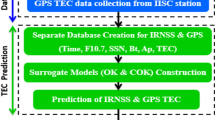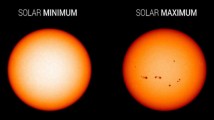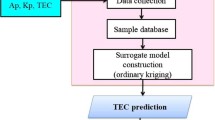Abstract
Total Electron Content (TEC) is used for calculation of Ionospheric delay. The Precise forecast of TEC is useful to correct the range measurements. TEC depends on the time of measurement, solar radiation (SSN & F10.7), geomagnetic index (AP & KP), season and geographic location of the user. In this paper, Cokriging geostatistical method is applied to build the Surrogate Model (COKSM) to estimate the range error based on predicted Vertical Total Electron Content (VTEC). The model is tested with pseudo-range measurements of L5 & S band data received from the operational NavIC/GPS receiver positioned at ACSCE, Bangalore, India and also using L1& L2 data of IGS network station. In order to assess the developed model, we have predicted and analyzed the ACSCE-NavIC TEC and IISC-GPS TEC and found that COKSM has predicted well for both NavIC (ACSCE) and GPS (IISC) TEC. The average RMSE of COKSM for NavIC TEC prediction is 1.4920 TECU, mean accuracy is 1.1151 TECU and average correlation coefficient is 0.9854. For GPS TEC prediction COKSM yields average RMSE of 1.1435 TECU, mean accuracy as 0.9080 TECU and average correlation coefficient of 0.9926. The average range error of NavIC and GPS are 0.2126 and 0.0938 meters. In order to estimate the performance of COKSM, it is compared with the Median model, Fourier series, NTCM-GL, SPM, LSTM and TIEGM/WEIMER models. Based on the comparison results it is observed that COKSM predicts well than other prediction models and provides the RMSE of 2.1480 TECU, correlation coefficient as 0.9810 and mean accuracy of 1.4044 TECU, also COKSM performs 4.6% better than Median model, 26.10% better than Fourier series model, 56.44% better than NTCM-GL, 56% superior than SPM model and 4.43% better than LSTM model. Apart from this, COKSM performance is assessed by comparing the forecasting results with TIEGM/WEIMER model during the St. Patrick’s storm and found that the average range error of COKSM is 1.65 m and TIEGM/Weimer model yields 2.06 m during the chosen period. These results indicate that COKSM gives better prediction results than other models and suitable for navigation applications.








Similar content being viewed by others
References
Ahmadi, S.H., Sedghamiz, A.: Application and evaluation of kriging and cokriging methods on groundwater depth mapping. Environ. Monit. Assess. 138, 357–368 (2008). https://doi.org/10.1007/s10661-007-9803-2
Ansari, K., Panda, S.K., Corumluoglu, O.: Mathematical modelling of ionospheric TEC from Turkish permanent GNSS Network (TPGN) observables during 2009–2017 and predictability of NeQuick and Kriging models. Astrophys. Space Sci. 363, 42 (2018). https://doi.org/10.1007/s10509-018-3261-x
Box, G.E.P., Jenkins, G.M., Reinsel, G.C., Ljung, G.M.: Time Series Analysis: Forecasting and Control, th edn. Wiley, New York (2015)
Cesaroni, C., Spogli, L., Aragon-Angel, A., Fiocca, M., Dear, V., et al.: Neural network based model for global total electron content forecasting. J. Space Weather Space Clim. 10, 11 (2020)
Ghanim, M.D., Lee, M.H.: A comparison between the performance of kriging and cokriging in spatial estimation with application. UTM Mathematika 29, 33–41 (2013)
Harsha, P.B.S., Ratnam, D.V.: Generation of regional ionospheric maps with EIA nowcasting/forecasting capability during geomagnetic storm conditions. IEEE Access 8, 57879–57890 (2020)
Huang, Z., Li, Q., Yuan, H.: Forecasting of ionospheric vertical TEC 1-h ahead using a genetic algorithm and neural network. Adv. Space Res. 55, 1775–1783 (2015)
Inyurt, S., Hasanpour Kashani, M., Sekertekin, A.: Ionospheric TEC forecasting using Gaussian process regression (GPR) and multiple linear regression (MLR) in Turkey. Astrophys. Space Sci. 365, 99 (2020). https://doi.org/10.1007/s10509-020-03817-2
Klobuchar, J.A.: Ionospheric time-delay algorithm for single-frequency GPS users. IEEE Trans. Aerosp. Electron. Syst. 23(3), 325–331 (1987)
Krishnan, S.R., Seelamantula, C.S.: On the selection of optimum Savitzky-Golay filters. IEEE Trans. Signal Process. 61(2), 380–391 (2013)
Li, S., Li, L., Wang, S., et al.: Comparative analysis of three ionospheric broadcast models for global navigation satellite systems. Acta Geophys. 65, 395–410 (2017). https://doi.org/10.1007/s11600-017-0030-0
Mallika, I.L., Ratnam, D.V., Raman, S., Sivavaraprasad, G.: A new ionospheric model for single frequency GNSS user applications using Klobuchar model driven by auto regressive moving average (SAKARMA) method over Indian region. IEEE Access 8, 54535–54553 (2020a). https://doi.org/10.1109/ACCESS.2020.2981365
Mallika, I.L., Ratnam, D.V., Raman, S., et al.: Performance analysis of Neural Networks with IRI-2016 and IRI-2012 models over Indian low-latitude GPS stations. Astrophys. Space Sci. 365, 124 (2020b). https://doi.org/10.1007/s10509-020-03821-6
Mallika, I.L., Ratnam, D.V., Ostuka, Y., Sivavaraprasad, G., Raman, S.: Implementation of hybrid ionospheric TEC forecasting algorithm using PCA-NN method. IEEE J. Sel. Top. Appl. Earth Obs. Remote Sens. 12(1), 371–381 (2019). https://doi.org/10.1109/JSTARS.2018.2877445
Martinez, C.A.: Multivariate geostatistical analysis of evapotranspiration and precipitation in mountainous terrain. J. Hydrol. 174(1–2), 19–35 (1996)
Mukesh, R., Soma, P., Karthikeyan, V., Sindhu, P.: Forecasting of ionospheric TEC for different latitudes, seasons and solar activity conditions based on OKSM. Astrophys. Space Sci. 365(1), 13 (2020)
Mukesh, R., Soma, P., Karthikeyan, V., Sindhu, P.: Analysis of signal strength, satellite visibility, position accuracy and ionospheric TEC estimation of IRNSS. Astrophys. Space Sci. 364, 196 (2019)
Pérez Bello, D., Natali, M.P., Meza, A.: Comparison of adaptive neuro-fuzzy inference system and recurrent neural network in vertical total electron content forecasting. Neural Comput. Appl. 31, 8411–8422 (2019). https://doi.org/10.1007/s00521-019-04528-8
Ratnam, D.V., Vindhya, G., Dabbakuti, J.K.: Ionospheric forecasting model using fuzzy logic-based gradient descent method. Geod. Geodyn. 8, 305–310 (2017)
Ratnam, D.V., Otsuka, Y., Sivavaraprasad, G., Dabbakuti, J.K.: Development of multivariate ionospheric TEC forecasting algorithm using linear time series model and ARMA over low-latitude GNSS station. Adv. Space Res. 63, 2848–2856 (2019)
Ronny, B., Borries, C., Hoque, M.M., Minkwitz, D.: Empirical forecast of quiet time ionospheric total electron content maps over Europe. Adv. Space Res. 61(12), 2881–2890 (2018)
Sabzehee, F., Farzaneh, S., Sharifi, M.A., Akhoondzadeh, M.T.E.: Regional modeling and prediction using ANN method and single frequency receiver over Iran. Ann. Geophys. 61, 103 (2018)
Sarma, A.D., Venkataratnam, D., Krishna Reddy, D.: Modelling of low latitude ionosphere using modified planar fit method for GAGAN. IET Radar Sonar Navig. 3(6), 609–619 (2009)
Seyed, H.A., Sedghamiz, A.: Application and evaluation of kriging and cokriging methods on groundwater depth mapping. Environ. Monit. Assess. 138(1–3), 357–368 (2008)
Sivavaraprasad, G., Deepika, V.S., SreenivasaRao, D., Ravi Kumar, M., Sridhar, M.: Performance evaluation of neural network TEC forecasting models over equatorial low-latitude Indian GNSS station. Geod. Geodyn. 11, 192–201 (2020)
Tebabal, A., Radicella, S., Damtie, B., Migoya-Orue, Y., Nigussie, M., Nava, B.: Feed forward neural network based ionospheric model for the East African region. J. Atmos. Sol.-Terr. Phys. 191, 105052 (2019)
Venkateswarlu, G., Sarma, A.D.: Performance of Holt-Winter and Exponential Smoothing Methods for Forecasting Ionospheric TEC Using IRNSS Data. ICECCT. IEEE Xplore, Coimbatore, India (2017)
Wang, C., Xin, S., Liu, X., et al.: Prediction of global ionospheric VTEC maps using an adaptive autoregressive model. Earth Planets Space 70, 18 (2018). https://doi.org/10.1186/s40623-017-0762-8
Watthanasangmechai, K., Supnithi, P., Lerkvaranyu, S., Tsugawa, T., Nagatsuma, T., Maruyama, T.: TEC prediction with neural network for equatorial latitude station in Thailand. Earth Planets Space 64, 473 (2012)
Wenqing, W., Xu, L., Huang, X., Zhang, W., Yuan, T., Chen, Z., Yan, Y.: Forecasting of Ionospheric Vertical Total Electron Content (TEC) Using LSTM Networks. IEEE, Coimbatore, India (2017)
Yates, S.R., Warrick, A.W.: Estimating soil water content using cokriging. Soil Sci. Soc. Am. J. 51(1), 23–30 (1987)
Yekoye, A.T.: Validation of the IRI 2016, IRI-Plas 2017 and NeQuick 2 models over the west pacific regions using the SSN and F10.7 solar indices as proxy. J. Atmos. Sol.-Terr. Phys. 195, 105055 (2019)
Zhang, R., Shouse, P., Yates, S.: Use of pseudo-crossvariograms and cokriging to improve estimates of soil solute concentrations. Soil Sci. Soc. Am. J. 61(5), 1342–1347 (1997)
Acknowledgement
The research work presented in this paper has been carried out under the project entitled “Surrogate model for ionospheric studies using IRNSS/GPS Data”, funded by SAC, ISRO, Ahmedabad.
Author information
Authors and Affiliations
Corresponding author
Ethics declarations
Disclosure Statement
No potential conflict of interest was reported by the authors.
Additional information
Publisher’s Note
Springer Nature remains neutral with regard to jurisdictional claims in published maps and institutional affiliations.
Rights and permissions
About this article
Cite this article
Mukesh, R., Karthikeyan, V., Soma, P. et al. Prediction of TEC using NavIC/GPS data with geostatistical method/forecasting capability comparison with other models. Astrophys Space Sci 365, 152 (2020). https://doi.org/10.1007/s10509-020-03868-5
Received:
Accepted:
Published:
DOI: https://doi.org/10.1007/s10509-020-03868-5




